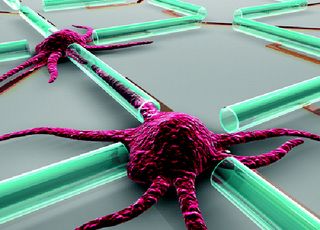Computers and Neurons Unite: Scientists Deepen Understanding of Brain

Combining neurons and computers in a new way could let scientists listen in on these cells talking to one another, deepening our understanding of the brain and paving the way for thought-controlled prosthetic limbs.
The University of Wisconsin researchers constructed nanoscale tubes of silicon and germanium, common materials used to make computer chips. They then placed mice neuron cells next to these tiny straw like tubes and watched as the cells’ axons – branches that carry information from the neuron – grew through the tubes. While this is not the first time that axons have been grown in the lab, it is the first time that they’ve been grown in semiconductor tubes that could potentially interface with electronics.
“Can we make devices that once are implanted can entice neurons to integrate and re-grow into them?” asked study co-author Justin Williams, an associate professor of biomedical engineering at the University of Wisconsin, Madison. “I don’t know whether this exact approach will be directly applicable to [implantation], but at the very least I think the things we can learn from these types of studies will inform the future development of implantable devices.”
The significance of this advance is twofold.
First, these semiconductor-based tubes have properties similar to the insulating layer that surrounds the axons, creating a more realistic environment for studying neurons.
Second, because the simulated myelin sheath is made out of semiconductors – the basic building block of computers – other electronic devices such as sensors and probes can be easily integrated with the tubes, which will allow scientists to watch and listen as the cells communicate with one another.
It’s not clear how these findings will be applied to the development of future brain implants, which include brain-computer interfaces.
Sign up for the Live Science daily newsletter now
Get the world’s most fascinating discoveries delivered straight to your inbox.
“At a basic science level, it may help us understand better how neurons interact with technology and how we might design future implantable devices that take advantage of that,” Williams told InnovationNewsDaily.
With processes typically used in the computer industry, the researchers were able to make tiny tubes of semiconductors. These tubes were mirrored after their biological counterpart, in the hopes that the axons would feel right at home in this environment and behave as they would in the body.
The result: The axons took to the tubes and grew through them with gusto.
The researchers hope that this attraction between the tubes and the neuron cells will let them create customized networks of these cells.
“Normally when you throw neurons in culture, they kind of bunch up with one another, they send out [axons], they connect to every other neuron in this random way and that’s not how the brain is formed, that’s not how the brain works,” Williams said. “If we can use the tubes to make predefined connections we may be able to make small circuits that would be better models of certain in vivo functions.”
The next step will be to integrate sensors into the tubes, Williams said.
Williams and colleagues detail their findings in the March 2 issue of the journal ACS Nano.
Most Popular


